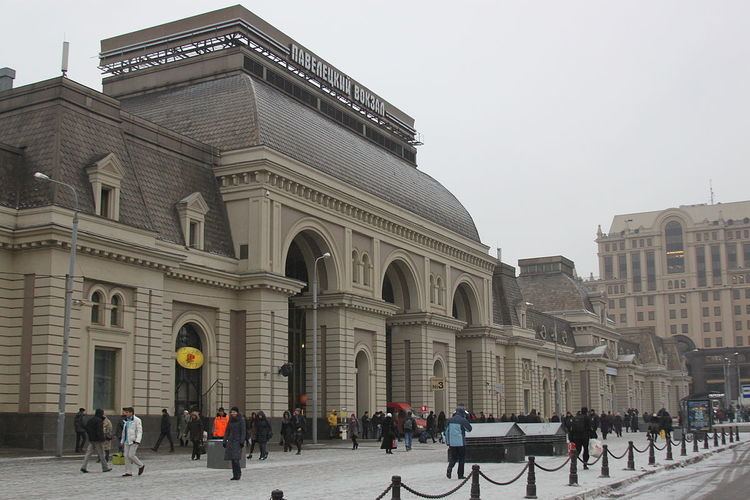Structure type at-grade Station code 193519 Address Moscow, Russia, 102151 Rebuilt 1980 Tracks 12 | Parking no Fare zone 0 Opened 1900 Platforms in use 10 | |
 | ||
Location Paveletskaya Square, Moscow, Russia Connections Moscow metro stations:
Paveletskaya
Paveletskaya Similar Paveletskaya, Moscow Kazanskaya railway st, Moscow Smolenskaya railway st, Moscow Kurskaya railway st, Moscow Kiyevskaya railway st | ||
Paveletsky station (Павелецкий вокзал) is one of Moscow's nine main railway stations. Originally called Saratovsky Railway Station, it was named after the settlement of Pavelets, when the railroad heading south-east from Moscow reached that point in 1899. The ornate building of the station, completed in 1900 and extensively reconstructed in the 1980s, remains one of the biggest Moscow railway stations. In 1924, it was the place where Muscovites came to meet the body of deceased Lenin. The Lenin Funeral Train is still a permanent exhibit at the Museum of the Moscow Railway. The Aeroexpress train links Paveletsky station with Domodedovo Airport. The station is operated by the Moscow Railway.
Contents
- Construction
- Reconstruction
- The Museum of the Moscow Railway
- Suburban destinations
- Airport connections
- References
The old building of the station was built in 1900, its architect was Alexander Krasovsky. In 1899 the Ryazan-Ural Railway reached Moscow, so that a new railway station was needed. From Paveletsky station suburban electric trains depart towards Kashira, Ozherelye, and Uzunovo. Express electric trains depart to Ozherelye and Domodedovo Airport. The major directions of long-distant trains are Almaty, Astrakhan, Baku, Balakovo, Balashov, Lipetsk, Saratov, Tambov, Volgograd, Voronezh, Yelets.
Construction
In the Russian Empire the Ryazano-Uralskaya Railway Company controlled the largest private railway, which connected 12 densely populated provinces. Still it did not have any connection with Moscow. So the Administration of the railway sent in an application to the Government for permitting to build a new branch between Moscow and Pavelets.
In 1897 Nicholas II granted his permission to build the branch.
The branch was finished 8.5 months earlier than it was scheduled. But the new railway road did not have a terminal in Moscow.
The station was built according to the architectural canons of the time: it was a symmetric building with a heightened center, large windows, wide and comfortable doorways. There were entrances, a vestibule, luggage space, waiting rooms for public, booking-offices, a telegraph, a pharmacy, and a bar at the front. There was a large operation hall in the center which separated rooms for the first and second class passengers from the rooms for the third class passengers.
The station was a brick building on a quarrystone foundation. It had two floors (three in the domed part) and many attics above the flanking buildings. The length of the station building was 83.7 meters. External walls were of 2.5 bricks depth, quite solid for a low building. External walls were revetted with special brick, the socle was revetted with ashlar, there were stucco mouldings in the vestibule and hall cornices. The solidity and reliability was felt in everything.
At the railway side there were service rooms, gendarme rooms, main tsar's rooms and outlets to the platforms. The railway station was very comfortable for its time, it was efficiently sited, had original heating services and a smart amphora turret used as a flagstaff.
The station was opened on 1 September 1900. A thanksgiving service with water consecration took place to mark the station's opening. The chief engineer V.V. Timofeev invited some other chiefs, station personnel and businessmen — future consignors of goods to the celebrations. Until the 1940s, the station was known as Saratovsky Railway Station. The railway between Moscow and Pavelets functioned already several months prior to the opening of the station, and the trains were rerouted to Kursky railway station.
Reconstruction
The old Paveletsky station was a part of the ensemble of the city square. When in 1980 it was decided to reconstruct the station the demands to the project were very strict. It was necessary to provide up-to-date comfort for passengers and simultaneously to retain the square skyline.
The reconstruction was realized by Mostransstroy trust. Architects A.Gurkov, S.Kuznetsova and A.Vorontsov solved the complicated constructive problem, keeping the old station's style. The new Paveletskiy station was re-opened on 3 November 1987.
The new station is six times larger by volume and four times by carrying capacity than the old one. It is capable to receive, serve and station in its halls about 10000 people at an hour. Now it is a large transport complex.
From the square the building seems to have one floor. But in fact there are three levels of passenger rooms, a technical level, and up-to-date service systems inside.
The Museum of the Moscow Railway
The museum of the Moscow Railway incorporates the former Museum of Lenin’s funeral train, including the locomotive and cars of Lenin's funeral train. The museum also documents the history of the Moscow Railway, and has outdoor exhibits at the Rizhsky railway station.
Suburban destinations
Suburban commuter trains (elektrichka) connect Paveletsky station with stations and platforms of the Paveletsky suburban direction of Moscow Railway, in particular, with the towns of Vidnoye (Rastorguyevo railway platform), Domodedovo, Stupino, Kashira, and Ozherelye, as well as with the Domodedovo Airport.
Airport connections
In addition to regular suburban trains, Paveletsky station is connected to Domodedovo International Airport by Aeroexpress trains. They were launched on August 3, 2002. They are not operated by Russian Railways though they use the same tracks.
